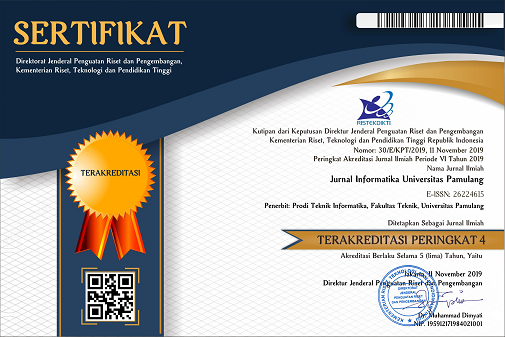Perbandingan Algoritma Klasifikasi K-Nearest Neighbor, Random Forest dan Gradient Boosting untuk Memprediksi Ketertarikan Nasabah pada Polis Asuransi Kendaraan
DOI:
https://doi.org/10.32493/informatika.v6i3.9419Keywords:
Klasifikasi, K-nearest neighbor, Random Forest, Gradient Boosting Classifier, Data MiningAbstract
An insurance policy provides coverage for compensation for specified loss, damage, illness, or death in exchange for premium payments. Likewise for vehicle insurance, every year the customer needs to pay a premium to the insurance company so that if an accident occurs that is not profitable for the vehicle, the insurance company provides compensation to the customer. The purpose of this research is to classify the health insurance cross-sell prediction dataset so that certain patterns or relationships can be found between the data to become valuable information and build a model to predict whether policyholders (customers) from the previous year will also be interested in insurance. Vehicles provided by the company. The researcher uses the K-nearest neighbor classification algorithm, Random Forest, and gradient boosting classifier as well as Python data mining tools. After doing the research, it was found that the K-nearest neighbor classification algorithm produces a higher accuracy of 91%, when compared to the Random Forest algorithm which is 87% and the boosting classifier algorithm is 88% in classifying customer interest in taking a vehicle insurance policy.
References
Dwiasnati, S., & Devianto, Y. (2019). Optimasi Prediksi Keputusan Calon Nasabah Potensial Berbasis Particle Swarm Optimization. 6(2), 286–292.
Fadillah, A. P. (2015). Penerapan Metode CRISP-DM Untuk Prediksi Kelulusan Studi Mahasiswa Menempuh Mata Kuliah ( Studi Kasus Universitas XYZ ). 1, 260–270.
Harismawan, A. F., Kharisma, A. P., & Afirianto, T. (2018). Analisis Perbandingan Performa Web Service Menggunakan Bahasa Pemrograman Python , PHP , Dan Perl Pada Client Berbasis Android. 2(1), 237–245.
Hasan, M. (2017). Menggunakan algoritma naive bayes berbasis. 9, 317–324.
Mustafa, M. S., Ramadha, M. R., & Thenata, A. P. (2017). Implementasi Data Mining Untuk Evaluasi Kinerja Akademik Mahasiswa Menggunakan Algoritma Naive Bayes Classifier. 4(2).
Muzakir, A., & Wulandari, R. A. (2016). Model Data Mining Sebagai Prediksi Penyakit Hipertensi Kehamilan Dengan Teknik Decision Tree. 3(1), 19–26.
Pertiwi, M. W., Adiwisastra, M. F., & [3], D. S. (2019). Analisa Komparasi Menggunakan 5 Metode Data Mining Dalam Klasifikasi Persentase Wanita Sudah Menikah Di Usia 15-49 Yang Memakai Alat KB (Keluarga Berencana). (November). Https://Doi.Org/10.31294/Jki.V7i1.5741
Ratnawati, L., & Sulistyaningrum, D. R. (2019). Penerapan Random Forest Untuk Mengukur Tingkat Keparahan Penyakit Pada Daun Apel. 8(2).
Salam, D., Musaruddin, M., & Mokui, H. T. (2020). Kombinasi Analisis Teknis Dan Algoritma Gradient Boosting Untuk Memprediksi Indeks Harga Saham Gabungan. 1–6.
Sanjaya, J., Renata, E., Budiman, V. E., Anderson, F., & Ayub, M. (2020). Prediksi Kelalaian Pinjaman Bank Menggunakan Random Forest Dan Adaptive Boosting. 6(April), 50–60.
Soemitra, A. (2017). Bank & Lembaga Keuangan Syariah. Jakarta: Kencana.
Utari, D. R., & Wibowo, A. (2020). Pemodelan Prediksi Status Keberlanjutan Polis Asuransi Kendaraan Dengan Teknik Pemilihan Mayoritas Menggunakan Algoritma-Algoritma Klasifikasi Data Mining. 5(2502), 19–24. Https://Doi.Org/10.22236/Teknoka.V5i.391
Utomo, D. P. (2020). Analisis Komparasi Metode Klasifikasi Data Mining Dan Reduksi Atribut Pada Data Set Penyakit Jantung. 4(April), 437–444. Https://Doi.Org/10.30865/Mib.V4i2.2080
Wijaya, N., & Ridwan, A. (2019). Klasifikasi Jenis Buah Apel Dengan Metode K-Nearest Neighbors. 8, 74–78.
Wiraguna, A., Faraby, S. Al, Sc, M., Adiwijaya, P., Si, S., & Si, M. (2019). Klasifikasi Topik Multi Label Pada Hadis Bukhari Dalam Terjemahan Bahasa Indonesia Menggunakan Random Forest. 6(1), 2144–2153.
Downloads
Published
Issue
Section
License
Authors who publish with this journal agree to the following terms:
- Authors retain copyright and grant the journal right of first publication with the work simultaneously licensed under a Creative Commons Attribution-NonCommercial 4.0 International (CC BY-NC 4.0) that allows others to share the work with an acknowledgement of the work's authorship and initial publication in this journal.
- Authors are able to enter into separate, additional contractual arrangements for the non-exclusive distribution of the journal's published version of the work (e.g., post it to an institutional repository or publish it in a book), with an acknowledgement of its initial publication in this journal.
- Authors are permitted and encouraged to post their work online (e.g., in institutional repositories or on their website) prior to and during the submission process, as it can lead to productive exchanges, as well as earlier and greater citation of published work (See The Effect of Open Access).
Jurnal Informatika Universitas Pamulang have CC-BY-NC or an equivalent license as the optimal license for the publication, distribution, use, and reuse of scholarly work.
In developing strategy and setting priorities, Jurnal Informatika Universitas Pamulang recognize that free access is better than priced access, libre access is better than free access, and libre under CC-BY-NC or the equivalent is better than libre under more restrictive open licenses. We should achieve what we can when we can. We should not delay achieving free in order to achieve libre, and we should not stop with free when we can achieve libre.
Jurnal Informatika Universitas Pamulang is licensed under a Creative Commons Attribution-NonCommercial 4.0 International (CC BY-NC 4.0)
YOU ARE FREE TO:
- Share : copy and redistribute the material in any medium or format
- Adapt : remix, transform, and build upon the material for any purpose, even commercially.
- The licensor cannot revoke these freedoms as long as you follow the license terms





